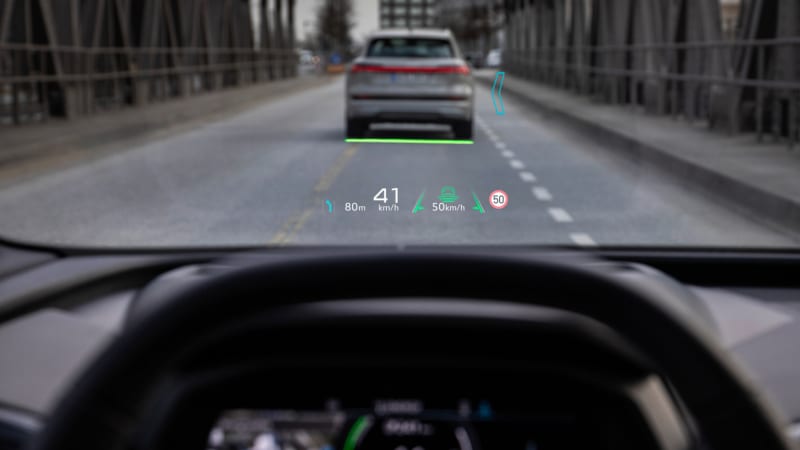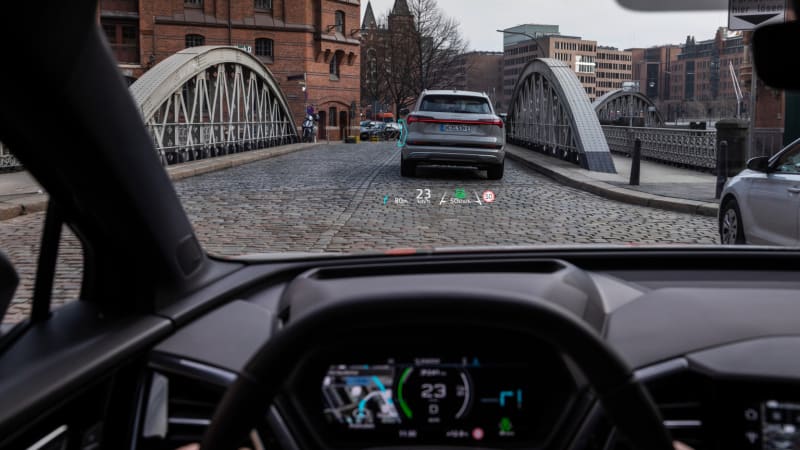Along with a more spacious cockpit, more storage space, and some improved cup holders, Audi has incorporated some serious new tech into its upcoming all-electric Q4 E-Tron compact crossover, including one Augmented Reality Heads-Up Display (HUD) that is reactive enough to closely follow a driver’s real world environment.
Audi on Tuesday unveiled the interior of the Q4 E-Tron, the fifth electric vehicle in its range and part of the German automaker’s plan to bring more than 30 electric vehicles and plug-in hybrids to market by 2025. The Q4 E-Tron was expected for some time; It was first presented as a concept at the 2019 Geneva Motor Show.
The exterior of the production version of the Q4 is still camouflaged, but we know its dimensions. The takeaway: An electric vehicle that fits into the larger compact SUV segment with a short overhang and 9.1 foot wheelbase – a combination that gives it a fairly sturdy look. However, this allows for an interior space of 6 feet long, such as that found in a large, full-size SUV.
The underlying architecture of the vehicle is based on the modular toolkit chassis or the MEB platform from the parent company VW. First introduced by VW in 2016, this flexible modular system was designed to make the production of a wide variety of electric vehicles more efficient and cost-effective. Thanks to the flat bottom, designers have more space to play. And they used this space by placing them in a center console with two cup holders, a 4.4 liter storage compartment with lid, two (or four optional) USB-C sockets and the Audi telephone booth (which can be charged wirelessly and wirelessly) stuck amplified the signal of your phone) on request.

The real story here is the technology – and most importantly, an option to add an AR-enabled windshield. The AR windshield offers a wider field of view and more accurate and dynamic animations than a standard windshield HUD. The Q4 E-Tron divides important displayed information into two sections: one for status and one for AR. The former, which appears about 3 meters in front of the driver, shows the driving speed, the traffic signs, the assistance system and the navigation symbols as static displays.
With the AR section, the driver perceives that the floating symbols are about 10 meters away. This will display information such as lane departure warnings overlaying a red line on the real lane marker and a colored stripe over an active car that is driving in front of you in active cruise control.
“Head-up displays are not new,” says Audi. “This only removes the field of vision, so that more active use is possible.”
The AR also displays navigation information. Audi calls the turning arrows “drones”, probably because the arrows fly ahead when driving straight ahead and then disappear and repeat themselves before the next action point. When the driver approaches an intersection, the drone announces the turn before the driver is precisely steered onto the road.

On the software side, the processing unit of the Q4 E-Tron called AR Creator records raw data from the front camera, radar sensor and GPS navigation of the vehicle in order to render display symbols at a speed of 60 frames per second and add them to the surroundings. The quality of these displays, indicated by a bit of advanced smoke and mirrors on what Audi calls the EV’s “imaging unit (PGU)” – basically lots of mirrors – will obviously determine how well it performs in real life is working. Since only simulations are currently available, it is not clear how well Audi will do this. A wider frame with dynamic symbols must fulfill its promise to appear “as clear as your real environment”, otherwise they will become a hindrance for the driver, and if they do not achieve the depth effect exactly, they can even lead to discomfort for the driver.
The Q4 E-Tron also has an updated voice control in natural language, which is activated with “Hey Audi”. The new car will also drop physical buttons on the steering wheel in favor of touch-sensitive buttons. But with an aesthetic feedback loop, it still feels like you’re pushing a button.
About 3% of the company’s sales in 2020or 47,000 vehicles were the electric E-Tron SUV and the E-Tron Sportback, a number that is sure to increase as the company continues to bring luxury electric vehicles to market.
Written by Rebecca Bellan for TechCrunch.



